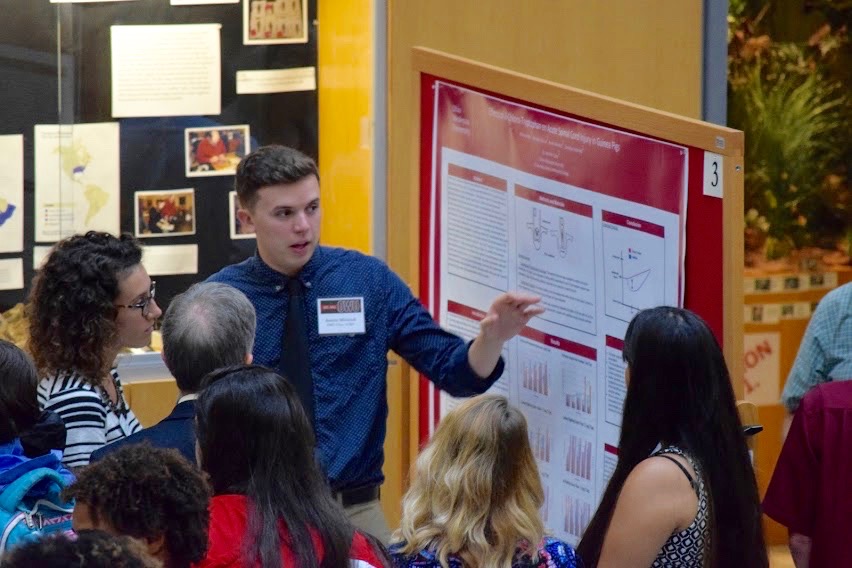By Shamayeta Rahman, Transcript Reporter
Summer means the sun, beaches, barbecues and research.
Students representing various fields in the sciences gathered in the Schimmel- Conrades Science Center’s atrium at noon, Sept. 26 to present the results of their summer-long research.
The room was filled with both student and faculty spectators, looking around the 27 poster boards. Rock Jones, the president of Ohio Wesleyan University, gave a speech commending the research students before joining the others in roaming around curiously listening to all the presentations. There were researches from multiple fields being presented by students who had a lot to share.
“Certain bacteria have feather degrading abilities,” said senior Jemil Seid. “I’m analyzing the biochemical differences between the slow degrading bacteria and the fast degrading bacteria.”
Seid, a biology major with a minor in chemistry, has been working with the Summer Science Research Program (SSRP) for the last two years. Earlier this summer, he won an award from the Ohio Branch of the American Society for Microbiology for his research about the antiviral properties of turmeric.
When speaking, he repeated multiple out for,” said senior Khayyam Zubair, who made an artificial intelligence game under Sean McCulloch’s guidance of the computer science department with his SSRP grant.
SSRP is a 10-week long program held over the summer, where selected students can work with a faculty adviser to work on their own research project. Students usually have to apply by the beginning of spring semester to be working the following summer, and receive a $3,200 stipend and free housing to carry out their research. This can be often combined with Theory-to-Practice Grants or Small Grant Program in certain cases.
This also ties in with the Research Experience for Undergraduates (REU) program for neuroscience that is available for students from other universities (Earlham College, Wooster College and Kenyon College) as well, and the program allows all selected students to access seven collaborative labs.
“REU was interesting because it allowed us to see different people doing different things using methods that I had never heard of before,” Semmedi said.
The SSRP prioritizes sophomores and juniors who have not participated previously, and recommends a GPA of 3.0 or above.
The deadline to apply for next year’s SSRP is January 2017.
Senior Austin Minnick explains his research to a group faculty and students times the importance of conducting research during undergraduate years.
“I did my research this time with a SIP grant,” Seid said. “Money was a little tight but I had absolute great mentorship, and my professors did everything to help and guide me through my research.”
Senior Cemaliye Semmedi, another SSRP grant recipient, said, “The funding was adequate but there is always room for more. The REU students received much bigger grants than the SSRP students and had a lot more flexibility.”
The sentiment echoed across the floor, but everyone agreed that despite the occasional financial constraints it was an essential experience for them to grow as researchers and apply their majors in resourceful ways.
“SSRP is such a great way to explore research opportunities, and if anyone is planning to go to graduate school it is always something that they are looking
